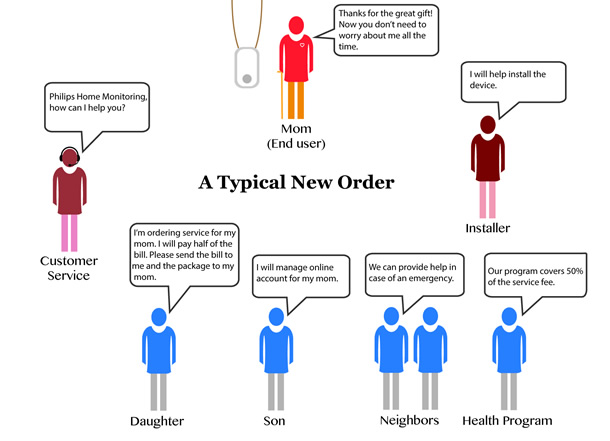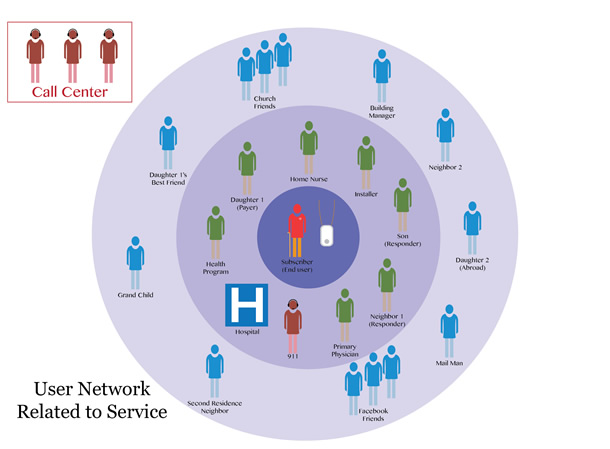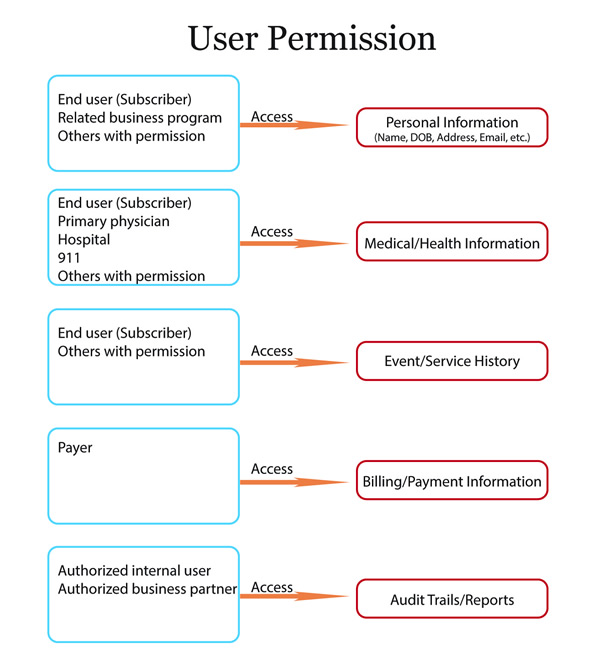Online shopping has never been easier. With a few clicks on a computer, tablet, or smartphone, customers can browse, pay, and manage their orders online. Features such as auto-recommendations, reviews, shopping cart reminders, and share-with-friends make the online shopping experience interactive, smart, and fun.
While digital and mobile technologies play an increasingly important role in many industries, companies in traditional healthcare like Philips Home Monitoring still rely on standard methods such as phone calls, paper bills, and manual data entry. Philips Home Monitoring, a business division of Philips Healthcare, provides 24/7 in-home and mobile emergency response, medication dispensing, and brain fitness solutions to seniors. The company currently assists more than 700,000 seniors and enables them to maintain independent living. Until two years ago, Philips Home Monitoring had no plans to move services online because we did not expect our subscribers, whose average age is 82, to know how to use a computer and go online for service.
However, company research indicated that the growth rate of senior web users increased rapidly during the past decade (see Table 1).
Table 1: US Internet Adoption Over Time, Ages 65+ vs. Age 30-49
| Age Group | Year Range | Increase | Annualized Growth Rate |
| Ages 30-49 | 2002-2012 | 58 to 73 million | 3% |
| Ages 65+ | 2004-2012 | 4.2 to 19 million | 16% |
With intense competition and the noticeable trend of healthcare digitization among healthcare agencies and our business partners, Philips Home Monitoring began to realize that providing the most up-to-date online experience was essential to our continued success. In addition, Pew Research Center reports that in 2013, 46 percent of senior citizens also used social networking sites (see Table 2).
Table 2: Use of Social Networking Site, by Age Group
| Age Group | 2006 | 2013 |
| Ages 18-29 | 49% | 90% |
| Ages 30-49 | 9% | 78% |
| Ages50-64 | 3% | 65% |
| Ages 65+ | 1% | 46% |
The company was surprised by these findings and began performing interviews with employees’ family and friends. Interview results confirmed that many seniors spent a significant amount of time on Facebook viewing updates by family and friends and interacting with their grandchildren. These findings increased the company’s confidence in creating an online service experience and expanded the project scope to include social media as a service channel.
The Project for Service Innovation began with three months of intensive workshops for service blueprinting: a design technique to visualize business processes and the service experience from the customer’s point of view. Originally, the project team expected the biggest challenge to be designing an online experience that fit the lifestyles of both seniors and their caregivers. However, before we even reached the design phase, our complicated business models, lack of information structure for user roles, and ambiguous definition of old and new concepts stopped us at the planning phase.
Unraveling the Communication Process for New Orders
Unlike a birthday gift that is purchased through a single transaction, or a cable subscription that can be set up through one event, healthcare services require a network of people’s active participation to ensure successful service delivery. The following is an example of a new order at Philips Home Monitoring (see Figure 1):

A new order requires interaction between multiple people and a significant amount of communication and coordination between subscribers, caregivers, and healthcare providers. Philips Home Monitoring also typically faces other scenarios, including coordinating multiple products, government contracts, and even additional vacation homes in other states with different emergency protocols and procedures.
Defining privacy within the user network
After the device is properly installed and the service is activated, user roles can change. In the event of an emergency, the network expands to include people that will take action, and further to people who will be notified or can offer backup support (see Figure 2). To support this, all personal and contact information, medical history, and communication records must be up-to-date in our system.

Many people willingly trade their privacy and personal information for online convenience. But in the healthcare industry, personal and medical information are highly sensitive and have strict regulations and compliance requirements, including the Health Insurance Portability and Accountability Act (HIPPA) and Payment Card Industry (PCI) standards.
To comply with these regulations and to protect our customers’ information, we tried to balance the user experience with business requirements such as privacy and information security. We found we needed to clearly define user roles and groups, assign access rights, and store user permissions. Some of the questions we grappled with included: Who are our customers and who are the target users of the digital world we are designing? How do we keep them secure in the online world? Should the online experience be open to everyone who has a role in a service? We addressed these critical questions during the planning phase of this project to ensure we provided the necessary information to the subscriber’s network of users while still complying with industry regulations.
Clarifying services and corresponding privacy levels
“Service” is the most foundational—yet difficult to understand—concept in healthcare. To define user roles and permissions, the project team first agreed on the type of service offerings and user activities that would happen online. As a healthcare service company, Philips Home Monitoring provides two types of services: product-enabled services and managed services. Product-enabled services typically appear on the bill, like a monthly monitoring fee. Managed services ensure the successful operation of the business: customer management, reporting, device management, data management, issue management, and knowledge management. The online user experience is critical to successful managed services.
To define the scope of the managed services and to map user stories during this planning phase, we used End2End, a methodology for documenting all business processes related to a company’s day-to-day activities. Processes are grouped by categories including Idea to Market, Market to Order, and Order to Cash, and include additional sub-processes to fully represent a company’s daily business activities. We used End2End to help us define the project scope, identify missing user stories, prioritize tasks, and share resources internally. For example, as a result of similar End2End processes identified, Philips Home Monitoring is collaborating with Philips Consumer Lifestyle in the Netherlands on sharing the same customer support system.
Next we began to define user roles and build the glossary. For each product and/or product-enabled service, the typical user roles are End-User, Payer (at Philips Home Monitoring, this is the end-user 40 percent of the time), Other Related External Users, Business Partners, and Philips Internal Employees. Each of these user roles requires access to different information through different channels and needs different levels of privacy access. Our task was to understand the type of information each user group needed, grant appropriate permissions, and design the authorization process (see Figure 3).

Mapping user groups to related information helped us decide the type of permissions to give and to whom. For example, an order confirmation will only be sent to the payer because it contains billing information. Therefore, a payer must always have access to the billing section online. If more access is needed, the payer must gain permission from the end-user (the subscriber). We also defined related concepts such as account, subscription, profile, and administrator, and avoided using pronouns such as “your information” or ”her account.” We found this helped users understand their roles and permissions. As a best practice, we always included the end-user name when communicating to different user groups.
Designing the user experience
Given the different age groups of our users, we knew they would have varying levels of technology exposure, and might not know their preferences or what to expect online. To help guide both senior web users and people who were new to the web through the learning process, we created our website with adjustable font sizes, simple web page structure, easy-to-use navigations, FAQs, and instructional videos. For complicated multi-step processes, we supplied detailed instructions to help users determine next steps and inform them of what would happen next. We determined all of these were critical in creating a streamlined, user-friendly process. We also built in required security controls such as a unique user identification URL, maximum wrong attempts, and inactivity log-out. We followed privacy and security guidelines including audit trails, privacy policies, and terms of use, which provided the user with a sense of reliability and security.
Designing the online experience required more than an external user interface and multi-tiered log-in credentials. It also required us to integrate multiple legacy systems containing duplicate and incomplete information stored across systems. This data and system integration requirement created extra challenges for displaying internal data to external users and in accepting feedback from external inputs. To allow users to manage their information online, we had to cleanup and standardize our internal data and make our processes flexible enough to allow information exchange from different channels. Philips Home Monitoring invested in the system integration by moving to a large cloud-based service platform for future expansion of product and service offerings.
Project development methodology and stakeholder communication
We used an agile approach for development and release. Agile allowed us to obtain user feedback for rapid iteration on design solutions, enabling continuous improvement. When the functionality to support an edge-case user scenario was not yet available, our customer support team filled in the missing functionality. Although some of the approval and authentication processes were in place already, due to the complicated nature of our business, we were still initially expecting phone calls as a primary way of contact. With support from cross-functional internal teams, within a short period of time we were able to grow the online experience from a single-user to a multi-user and multi-product experience. In the meantime, we continue to expand online services offerings, streamline the user experience, and decrease the need for in-person support.
For healthcare service design in general, and depending on the nature of the project, transforming the customer experience can take a few months to a few years or longer to complete. In our case, the project involved different subject matter expertise and touched multiple business areas. Effective and frequent communication was crucial to the success of our service innovation. At the beginning, we shared a project vision with different internal groups. To communicate our vision, we used techniques including an elevator pitch, personas, videos, service blueprints, and Visio flowcharts. We selected different formats based on the type of team we were communicating with. Particularly at the management level, it was critical to the success of the project to have people on board as early as possible. To make people aware of upcoming changes and possible impacts during the project, we communicated through newsletters and milestone presentations. After the design was completed, we invited different internal groups to be part of the internal beta testing process, to provide us with early feedback prior to launching with external users.
Lessons Learned in a Traditional Healthcare Company
The emergence and adoption of new technologies is radically changing the relationship between healthcare companies and their customers. Providing online services helps us reduce costs and increase operational efficiencies, and allows us to stay better connected with our customers—both current subscribers and the next generation of seniors and their caregivers. We learned that instead of considering the digital service experience as a bonus to customers, we should consider it a collaborative advantage in helping us understand the needs of our customers, deliver better care, and improve our operational efficiencies. As our business continues to grow and our services platform becomes cloud-based, issues such as regulatory compliance, privacy, usability challenges, and online information security will continue to require us to build feedback loops to capture user interactions. Through continuous improvement, healthcare companies can be ready to use newer technology to provide the best user experience for their customers.
[greybox]
Text in Figure 1: A Typical New Order
Each person in the diagram has a different perspective:
- Customer Service: Phillips Home Monitoring, how can I help you?
- Daughter: I’m ordering service for my mom. I will pay half of the bill. Please send the bill to me and the package to my mom.
- Son: I will manage the online account for my mom.
- Neighbors: We can provide help in case of an emergency.
- Health program: Our program covers 50 percent of the service fee.
- Installer: I will help install the device.
- Mom (end-user): Thanks for the great gift! Now you don’t need to worry about me all the time.
[/greybox]
[greybox]
Text in Figure 3: Map of Information Needs
Mapping of user roles who can access different types of information.
- End-user (Subscriber), Related business program, Others with permission: Personal information (Name, DOB, Address, Email)
- End-user (Subscriber), Primary physician, Hospital, 911, Others with permission: Medical/Health Information
- End-user (Subscriber), Others with permission: Event/Service History
- Payer: Billing/Payment Information
- Authorized internal user, Authorized business partner: Audit Trails/Reports
[/greybox]新技术正在从根本上改变健康保健公司与其客户之间的关系。在为老年用户及其护理人员创造在线自助服务体验时,需要面对各种挑战,例如:在开始时错误地假设用户的电脑使用水平、理解用户的保健网络和所需的服务水平、隐私约束、在旧系统和基于云技术的系统之间整合信息、项目开发方法、利益相关方沟通策略以及经验教训。 文章全文为英文版
새로운 기술들은 의료 회사와 그 고객들 간의 관계에 급격한 변화를 가져오고 있습니다. 고령 사용자와 그들의 보호자들에 있어서 온라인 셀프 서비스 경험을 창출하는 데는 컴퓨터 사용 수준에 관한 잘못된 초기 가정, 사용자의 케어 네트워크와 필요한 서비스 수준, 개인사생활 제약, 구형 시스템과 클라우드 기반의 시스템 간의 정보 통합, 프로젝트 개발 방법, 이해당사자 소통 전략, 그리고 터득한 교훈 등의 난제에 직면해야 했습니다. 전체 기사는 영어로만 제공됩니다.
As novas tecnologias estão mudando radicalmente o relacionamento entre as empresas de serviço de saúde e seus clientes. A criação de uma experiência de auto-atendimento on-line para usuários idosos e seus cuidadores enfrentam desafios como suposições iniciais errôneas sobre níveis de utilização de computador, compreensão da rede de assistência ao usuário e dos níveis de serviço necessários, limitações de privacidade, integração de informações entre sistemas herdados e baseados em nuvem, metodologia de desenvolvimento de projeto, estratégias de comunicação com interessados e lições aprendidas. O artigo completo está disponível somente em inglês.
新しいテクノロジーは、ヘルスケア企業とその顧客との関係を根本的に変えつつある。高齢ユーザーおよびその介護者向けのオンラインセルフサービス体験を創出するためには、コンピューターの使用レベルに関する当初の誤った思い込み、ユーザーのケアのネットワークと必要なサービスレベルの理解、プライバシーの制約、従来およびクラウドベースのシステムの情報の統合、プロジェクトの開発方法、利害関係者とのコミュニケーション戦略、および前例からの教訓などの課題があることがわかった。 原文は英語だけになります
Las nuevas tecnologías están cambiando radicalmente la relación entre las compañías de atención médica y sus clientes. Crear una experiencia de autoservicio en línea para personas mayores y quienes los cuidan implica enfrentarse a desafíos como suposiciones iniciales erróneas sobre los niveles de uso informático, comprender la red de cuidados del usuario y los niveles de servicio requeridos, restricciones de privacidad, integración de la información entre sistemas preexistentes y los basados en la nube, metodologías de desarrollo de proyecto, estrategias de comunicación con las partes interesadas y lecciones aprendidas. La versión completa de este artículo está sólo disponible en inglés
